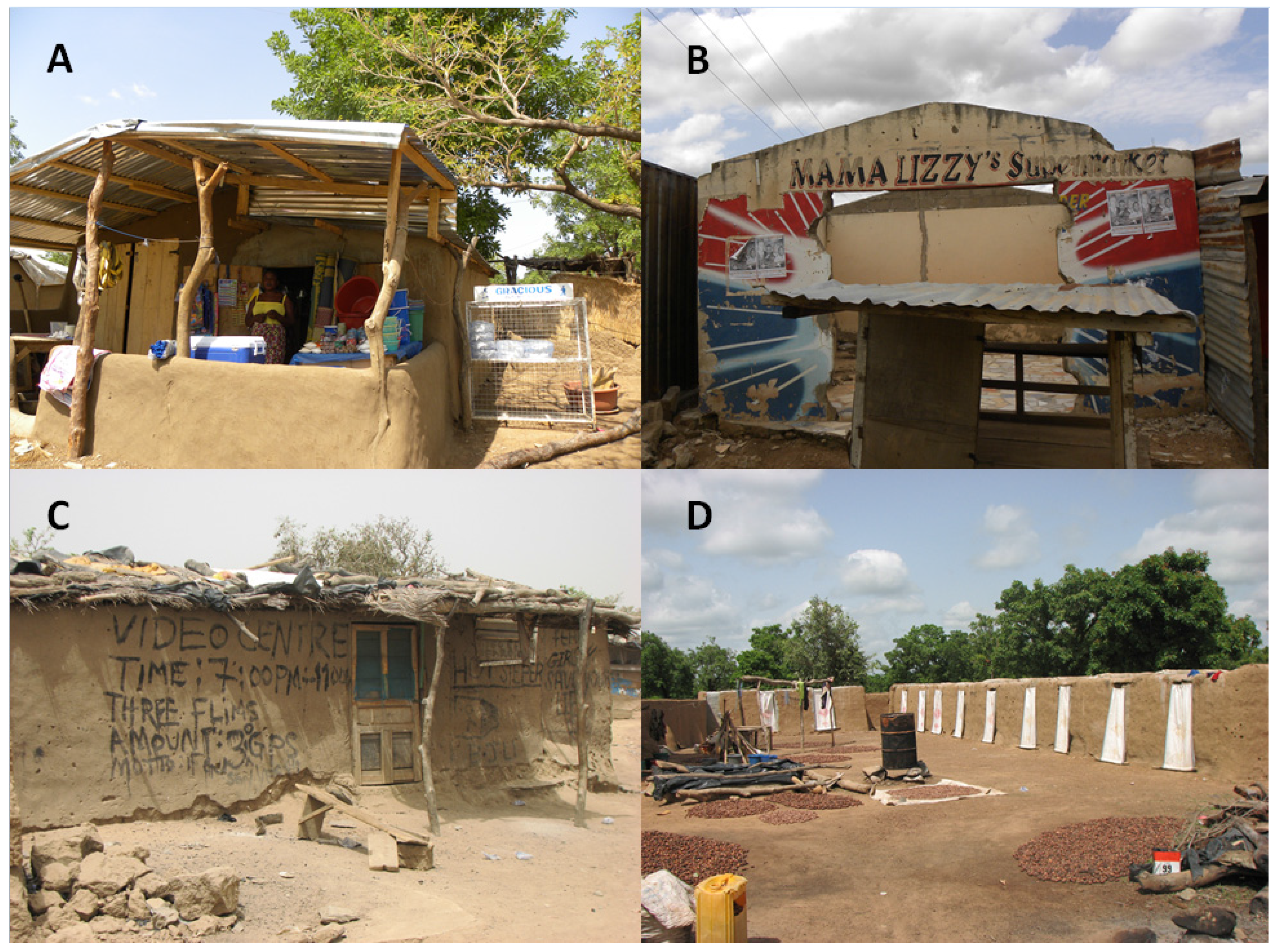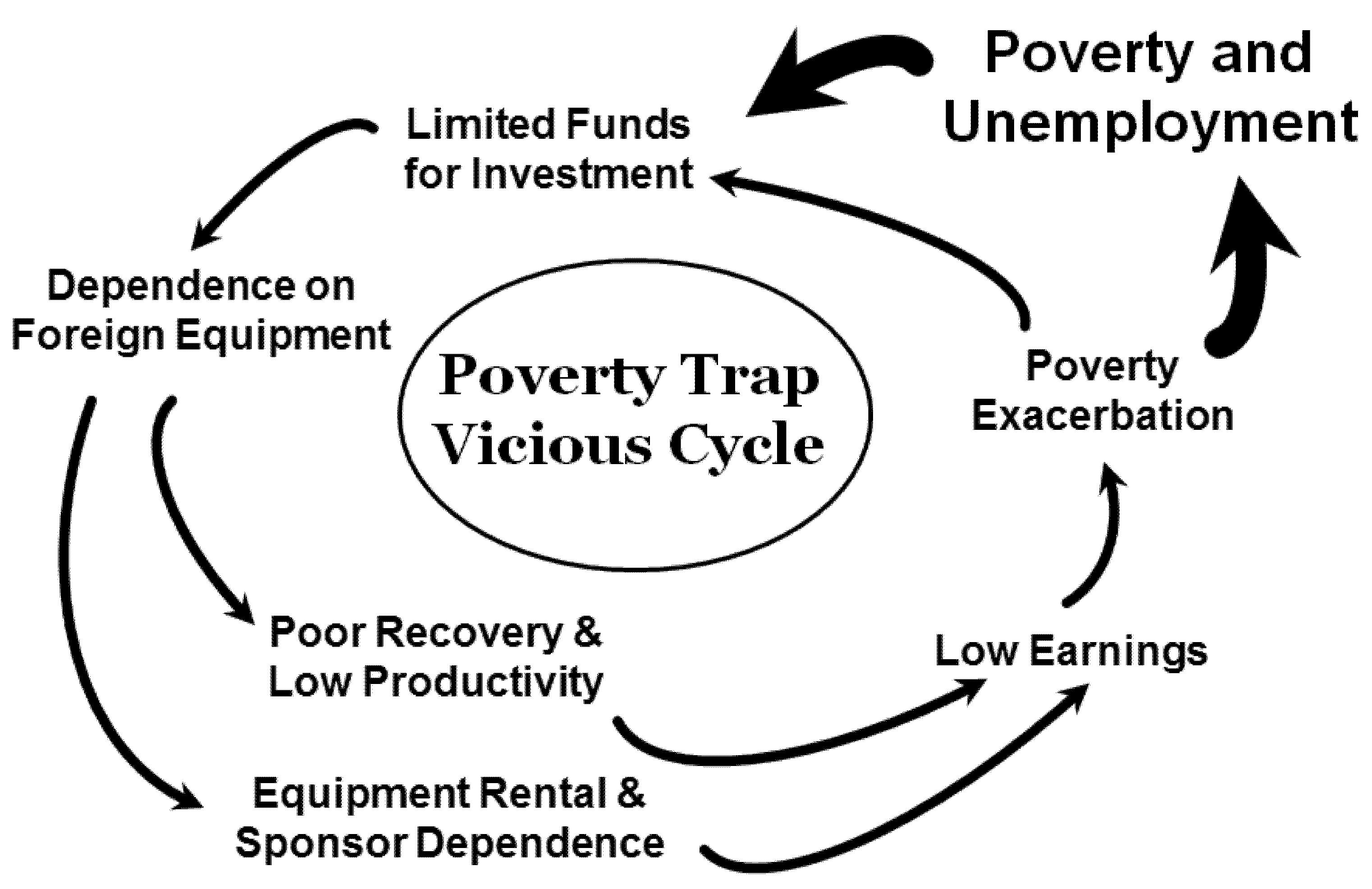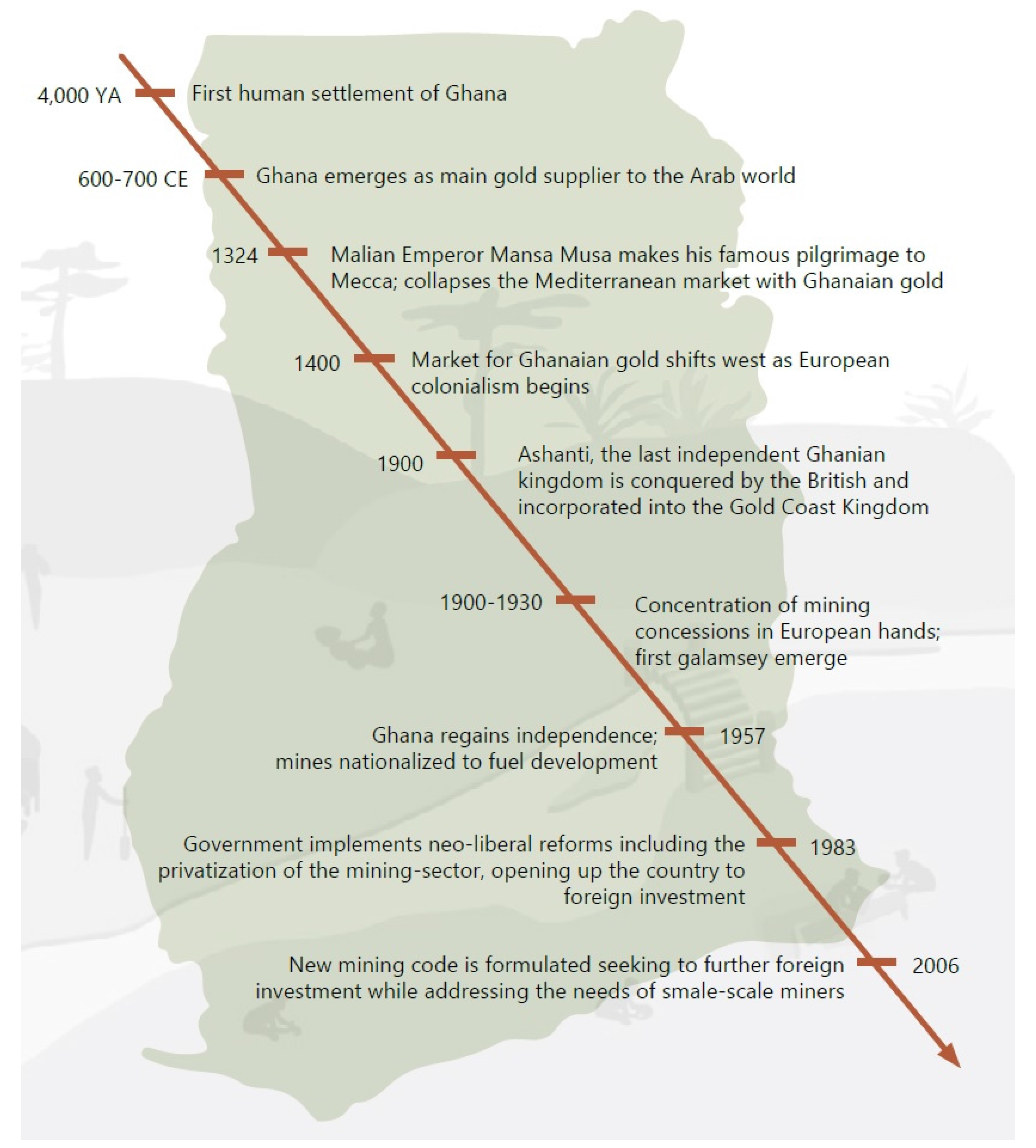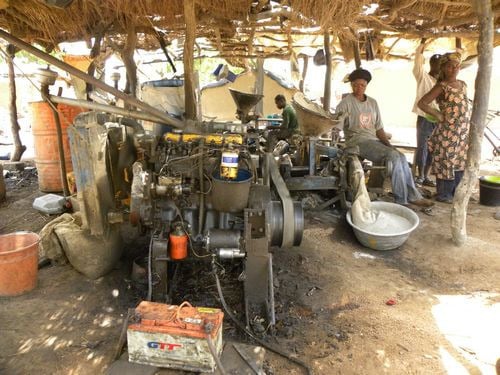Integrated Assessment of Artisanal and Small-Scale Gold Mining in Ghana — Part 3: Social Sciences and Economics
Abstract
:1. Introduction

1.1. Objective
1.2. Limitations and Assumptions
2. An Assessment of Social and Economic Issues
2.1. Poverty and Livelihood: Microeconomic Effects and Needs

2.1.1. Causes

2.1.2. Status and Trends

2.1.3. Consequences
2.1.4. Certainty Analysis
2.2. Macroeconomic Effects, Policies and Programs
2.2.1. Causes
2.2.2. Status and Trends
2.2.3. Consequences
2.2.4. Certainty Analysis
2.3. Legalization, Formalization and Enforcement
2.3.1. Causes
2.3.2. Status and Trends
2.3.3. Consequences
2.3.4. Certainty Analysis
3. Conclusions and Implications
| Summary of Policy Suggestions |
Social and economic policies to regularize ASGM activities are likely to be most effective if they are clearly articulated incentives, developing out of "partnerships" with the Minerals Commission, and be easy for miners to understand and follow. Only by assisting miners with means to improve their practices, develop community infrastructure, and employ safer methods will ASGM activities have less environmental impact and greater positive impact on people’s health and well-being. Specific suggestions include:
|
Acknowledgements
Author Contributions
Conflicts of Interest
References
- Ghana Chamber of Mines. Performance of the Industry in 2012. Available online: http://ghanachamberofmines.org/media/publications/Performance_of_the_Ghana (accessed on 7 July 2015).
- GoldPrices. Available online: http://www.goldprices.com/historical-gold-prices.htm (accessed on 7 July 2015).
- Communities, Artisanal and Small-Scale Mining (CASM ); World Bank: Washington, DC, USA, 2008; pp. 1–4.
- Chupezi, T.J.; Ingram, V.; Schure, J. Impacts of Artisanal Gold and Diamond Mining on livelihoods and the Environment in the Sangha Tri-National Park Landscape; Center for International Forestry Research (CIFOR): Yaounde, Cameroon, 2009. [Google Scholar]
- Tschakert, P. Digging Deep for Justice: A radical re-imagination of the artisanal gold mining sector in Ghana. Antipode 2009, 41, 706–740. [Google Scholar] [CrossRef]
- U.N. Economic Commission for Africa. Minerals and Africa’s Development: The International Study Group Report on Africa’s Mineral Regimes; Economic Commission on Africa: Addis Ababa, Ethiopia, 2011. [Google Scholar]
- Tetteh, K. An Overview of Ghana’s Artisanal and Small Scale Mining (ASM) Sector; Ghana Minerals Commission: Accra, Ghana, 2011. [Google Scholar]
- Mohammed Banchirigah, S. How have reforms fuelled the expansion of artisanal mining? Evidence from sub-Saharan Africa. Resour. Policy 2006, 31, 165–171. [Google Scholar]
- Labonne, B. Commentary: Harnessing mining for poverty reduction, especially in Africa. Nat. Resour. Forum 2002, 26, 69–73. [Google Scholar] [CrossRef]
- Hilson, G.; Potter, C. Structural adjustment and subsistence industry: Artisanal gold mining in Ghana. Dev. Chang. 2005, 36, 103–131. [Google Scholar] [CrossRef]
- Tschakert, P. Recognizing and nurturing artisanal mining as a viable livelihood. Resour. Policy 2009, 34, 24–31. [Google Scholar] [CrossRef]
- Aubynn, A. Sustainable solution or a marriage of inconvenience? The coexistence of large-scale mining and artisanal and small-scale mining on the Abosso goldfields concession in western Ghana. Resour. Policy 2009, 34, 64–70. [Google Scholar] [CrossRef]
- Hilson, G. A Contextual Review of the Ghanaian Small-scale Mining Industry; Imperial College Centre for Environmental Technology: London, UK, 2002. [Google Scholar]
- World Bank. Staff Appraisal Report, Republic of Ghana, Mining Sector Development and Environmental Project (World Bank Report No. 13881-GH); World Bank: Washington, DC, USA, 1995. [Google Scholar]
- Hilson, G.M.; Potter, C. Why is illegal gold mining activity so ubiquitous in rural Ghana? Afr. Dev. Rev. 2003, 15, 237–270. [Google Scholar] [CrossRef]
- Kessey, K.D.; Arko, B. Small scale gold mining and environmental degradation, in Ghana: Issues of mining policy implementation and challenges. J. Stud. Soc. Sci. 2013, 5, 12–30. [Google Scholar]
- Basu, N.; Clark, E.; Green, A.; Long, R.; Quansa, R.; Neitzel, R.; Mozhgon, R.; Wilson, M.L.; Chang, L.; Obiri, S.; et al. Integrated assessment of artisanal and small-scale gold mining in Ghana—Part 1: Human health review. Int. J. Environ. Res. Public Health 2015, 12, 5143–5176. [Google Scholar] [CrossRef] [PubMed]
- Rajaee, M.; Obiri, S.; Green, A.; Long, R.; Cobbina, S.; Nartey, V.; Buck, D.; Antwi, E.; Basu, N. Integrated assessment of artisanal and small-scale gold mining in Ghana—Part 2: Natural sciences review. Int. J. Environ. Res. Public Health 2015, in press. [Google Scholar]
- Special Issue Integrated Assessment of Artisanal and Small-Scale Gold Mining (ASGM) in Ghana. Available online: https://www.mdpi.com/journal/ijerph/special_issues/asgm (accessed on 7 July 2015).
- Vaccaro, L.; Read, J.; Diana, J.; Horningm, A.; Scavia, D. Tackling Wicked Problems through Integrated Assessment: A Guide for Decision Makers, Project Leaders and Scientists; Regents of the University of Michigan: Ann Arbor, MI, USA, 2009; pp. 1–23. [Google Scholar]
- Scavia, D.; Nassauer, J. Policy insights from integrated assessments and alternative futures. In From the Corn Belt to the Gulf: Societal and Environmental Implications of Alternative Agricultural Futures; Nassauer, J., Santlemann, M., Scavia, D., Eds.; Resources for the Future: Washington, DC, USA, 2007; pp. 1–8. [Google Scholar]
- Lund, K.; Dinse, K.; Callewaert, J.; Scavia, D. Benefits of using integrated assessment to address sustainability challenges. J. Environ. Stud. Sci. 2011, 1, 289–295. [Google Scholar] [CrossRef]
- Ofosu-Mensah, A.E. Gold mining in Adanse. Nord. J. Afr. Stud. 2010, 19, 124–147. [Google Scholar]
- Ofosu-Mensah, E.A. Historical overview of traditional and modern gold mining in Ghana. Int. Res. J. Libr. Inf. Arch. Stud. 2011, 1, 6–22. [Google Scholar]
- Emmanuel, A. Mining as a factor of social conflict in Ghana. Glob. J. Hist. Cult. 2012, 1, 7–21. [Google Scholar]
- Ofosu-Mensah, A.E. Gold Mining in Adanse: Pre-Colonial and Modern; SLAP Lambert Academic Publishing: Aarbrücken, Germany, 2014. [Google Scholar]
- Eshun, P.A. Sustainable small-scale gold mining in Ghana: setting and strategies for sustainability. In Sustainable Minerals Operations in the Developing World; Marker, B.R., Petterson, M.G., McEvoy, F., Stephenson, M.H., Eds.; Geological Society: London, UK, 2005; Volume 250, pp. 61–72. [Google Scholar]
- Hilson, G. Once a miner, always a miner: Poverty and livelihood diversification in Akwatia, Ghana,”. J. Rural Stud. 2010, 26, 296–307. [Google Scholar] [CrossRef]
- Hilson, G.M. Child labour in African artisanal mining communities: Experiences from northern Ghana. Dev. Chang. 2010, 41, 445–473. [Google Scholar] [CrossRef]
- Long, R.; Renne, E.; Basu, N. Public health risks associated with small-scale gold mining community. Personal Comunication, 2015. [Google Scholar]
- Paruchuri, Y.; Siuniak, A.; Johnson, N.; Levin, E.; Mitchell, K.; Goodrich, J.M.; Renne, E.P.; Basu, N. Occupational and environmental mercury exposure among small-scale gold miners in the Talensi-Nabdam District of Ghana’s upper east region. Sci. Total Environ. 2010, 408, 6079–6085. [Google Scholar] [CrossRef] [PubMed]
- Okoh, G.; Hilson, G.M. Poverty and livelihood diversification: Exploring the linkages between smallholder farming and artisanal mining in rural Ghana. J. Int. Dev. 2011, 23, 1100–1114. [Google Scholar] [CrossRef]
- Hentschel, T.; Hruschka, F.; Priester, M. Global Report on Artisanal & Small-Scale Mining. Available online: http://pubs.iied.org/pdfs/G00723.pdf (accessed on 7 July 2015).
- Yakovleva, N. Perspectives on female participation in artisanal and small-scale mining: A case study of Birim north district of Ghana. Resour. Policy 2007, 32, 29–41. [Google Scholar] [CrossRef]
- Hilson, G. Poverty traps in small-scale mining communities: The case of sub-Saharan Africa. Can. J. Dev. Stud. 2012, 33, 180–197. [Google Scholar] [CrossRef]
- Heemskerk, M. Collecting data in artisanal and small-scale mining communities: Measuring progress towards more sustainable livelihoods. Nat. Resour. Forum 2005, 29, 82–87. [Google Scholar] [CrossRef]
- Hilson, G.M.; Banchirigah, S.M. Are alternative livelihood projects alleviating poverty in mining communities? Experiences from Ghana. J. Dev. Stud. 2009, 45, 172–196. [Google Scholar] [CrossRef]
- Boadu, K.A. Anti-Galamsey Task Force Resumes Operation Soon. Available online: http://graphic.com.gh/news/general-news/18540-anti-galamsey-task-force-resumes-operation-soon.html (accessed 9 October 2014).
- Hinton, J.J.; Veiga, M.M.; Veiga, A.T.C. Clean artisanal gold mining: A utopian approach? J. Clean. Prod. 2003, 11, 99–115. [Google Scholar] [CrossRef]
- Hilson, G.; Pardie, S. Mercury: An agent of poverty in Ghana’s small-scale gold-mining sector? Resour. Policy 2006, 31, 106–116. [Google Scholar] [CrossRef]
- United Nations Economic Commission for Africa. Reports on Selected Themes in Natural Resources Development in Africa : Artisanal and Small-Scale Mining and Technology Challenges; UNECA: Addis Ababa, Ethiopia, 2003; pp. 1–15. [Google Scholar]
- Appiah, H. Organization of small scale mining activities in Ghana. J. South Afr. Inst. Min. Metall. 1998, 98, 307–310. [Google Scholar]
- Teschner, B.A. Small-scale mining in Ghana: The government and the galamsey. Resour. Policy 2012, 37, 308–314. [Google Scholar] [CrossRef]
- Junner, N.R.; Wild, R.P. Gold in the Gold Coast; Government Printer: Accra, Ghana, 1935. [Google Scholar]
- Spooner, A.C. Buck McGuiness and Jock Reid; Bodleian Library, Oxford University: Oxford, UK; pp. 1935–1937.
- Renne, E. Small-scale and industrial gold mining histories in Nangodi, UER, Ghana. J. West. Afr. Hist. 2015, in press. [Google Scholar]
- Hilson, G.; Amankwah, R.; Ofori-Sarpong, G. Going for gold: Transitional livelihoods in northern Ghana. J. Mod. Afr. Stud. 2013, 51, 109–137. [Google Scholar] [CrossRef]
- Ofosu-Mensah Ababio, E. The impact of indigenous gold mining on Akyem Abuakwa communities during the Pre-Colonial Era. Personal Communication.
- Yakovleva, N. Perspectives on Female Participation in Artisanal and Small-Scale Mining : A Case Study of Birim North District of Ghana; The Centre For Business Relationships, Accountability, Sustainability and Society, Cardiff University: Cardiff, UK, 2006. [Google Scholar]
- Fisher, E.; Mwaipopo, R.; Mutagwaba, W.; Nyange, D.; Yaron, G. The ladder that sends us to wealth’: Artisanal mining and poverty reduction in Tanzania. Resour. Policy 2009, 34, 32–38. [Google Scholar] [CrossRef]
- Spiegel, S.J. Governance institutions, resource rights regimes, and the informal mining sector: Regulatory complexities in Indonesia. World Dev. 2012, 40, 189–205. [Google Scholar] [CrossRef]
- Tenkorang, E. Illegal Small Scale Mining in Ghana: A Protest of Tradition against Modernity? Available online: http://asgmresearch.weebly.com/illegal-small-scale-mining-in-ghana-a-protest-of-tradition-against-modernity.html (accessed on 7 July 2015).
- International Labor Organization. Social and Labor Issues in Small-Scale Mines; Sectoral Activities Program, International Labor Organization, International Labor Office: Geneva, Switzerland, 1999. [Google Scholar]
- McTernan, B.A. Ghana: Small Scale Mining Useful to Economy. Available online: http://www.theafricareport.com/West-Africa/ghana-small-scale-mining-useful-to-economy.html (accessed on 7 July 2015).
- Mireku-Gyimah, D. To mine or not to mine: The economic controversy and its resolution. In Collabrative Governance in Extractive Industries in Africa; United Nations University Institute for Natural Resources in Africa: Accra, Ghana, 2012; pp. 1–30. [Google Scholar]
- Long, R.; Renne, E.; Robins, T.; Wilson, M.; Pelig-ba, K.; Yee, A.; Koomson, E.; Sharp, C.; Lu, J.; Basu, N. Water values in a Ghanaian small-scale gold mining community. Hum. Organ. 2013, 72, 199–210. [Google Scholar] [CrossRef]
- Akabzaa, T.M.; Seyire, J.S.; Afriyie, K. The Glittering Facade: Effects of Mining Activities on Obuasi and Its Surrounding Communities; Third World Network—Africa (TWN—Africa): Accra, Ghana, 2007. [Google Scholar]
- Banchirigah, S.M.; Hilson, G.M. De-agrarianization, re-agrarianization and local economic development: Re-orientating livelihoods in African artisanal mining communities. Policy Sci. 2009, 43, 157–180. [Google Scholar] [CrossRef]
- Hilson, G.M.; Maponga, O. How has a shortage of census and geological information impeded the regularization of artisanal and small-scale mining ? Nat. Resour. Forum 2004, 28, 22–33. [Google Scholar] [CrossRef]
- Kurantin, N.Y.D. A framework for monitoring sustainable development: A core set of rural development indicators to assist the assessment of developing sustainable rural mining communities. OIDA Int. J. Sustain. Dev. 2010, 7, 89–97. [Google Scholar]
- Yaro, J.A. Customary tenure systems under siege: Contemporary access to land in northern Ghana. GeoJournal 2010, 75, 199–214. [Google Scholar] [CrossRef]
- Tsikata, F.S. The vicissitudes of mineral policy in Ghana. Resour. Policy 1997, 23, 9–14. [Google Scholar] [CrossRef]
- World Bank. Implementation Status & Results Ghana. Natural Resources and Environmental Governance Technical Assistance (P129769) Report No. ISR15549; World Bank: Washington, DC, USA, 2014; pp. 1–4. [Google Scholar]
- Bush, R. Soon there will be no-one left to take the corpses to the morgue’: Accumulation and abjection in Ghana’s mining communities. Resour. Policy 2009, 34, 57–63. [Google Scholar] [CrossRef]
- United Nations Environment Programme (UNEP). Minamata Convention on Mercury. Available online: http://www.mercuryconvention.org/ (accessed on 6 April 2015).
- Spiegel, S.; Keane, S.; Metcalf, S.; Veiga, M. Implications of the minamata convention on mercury for informal gold mining in Sub-Saharan Africa: From global policy debates to grassroots implementation? Environ. Dev. Sustain. 2014, 17, 1–21. [Google Scholar] [CrossRef]
- Shields, D.J.; Solar, S.V. Sustainable development and minerals: Measuring mining’s contribution to society. Geol. Soc. Lond. Spec. Public 2005, 250, 195–211. [Google Scholar] [CrossRef]
- Saldarriaga-Isaza, A.; Villegas-Palacio, C.; Arango, S. The public good dilemma of a non-renewable common resource: A look at the facts of artisanal gold mining. Resour. Policy 2013, 38, 224–232. [Google Scholar] [CrossRef]
- Hobbs, J.C.A. Enhancing the contribution of mining to sustainable development. Geol. Soc. Lond. Spec. Public 2005, 250, 9–23. [Google Scholar] [CrossRef]
- Akabzaa, T.; Darimani, A. Impact of Mining Sector Investment in Ghana: A Study of the Tarkwa Mining Region. Available online: https://www.ifcamc.org/userfiles/files/1466_file_Impact_20of_20Mining_20Sector_20Investment_20in_20Ghana.pdf (accessed on 7 July 2015).
- Dumett, R. Disease and mortality among gold miners of Ghana: Colonial government and mining company attitudes and policies, 1900–1938. Soc. Sci. Med. 1993, 37, 213–232. [Google Scholar] [CrossRef]
- Banchirigah, S.M. Challenges with eradicating illegal mining in Ghana: A perspective from the grassroots. Resour. Policy 2008, 33, 29–38. [Google Scholar] [CrossRef]
- Sinding, K. The dynamics of artisanal and small-scale mining reform. Nat. Resour. Forum 2005, 29, 243–252. [Google Scholar] [CrossRef]
- Spiegel, S.J. Microfinance services, poverty and artisanal mineworkers in Africa: In search of measures for empowering vulnerable groups. J. Int. Dev. 2012, 517, 485–517. [Google Scholar] [CrossRef]
- Hilson, G. Small-scale mining and its socio-economic impact in developing countries. Nat. Resour. Forum 2002, 26, 3–13. [Google Scholar] [CrossRef]
- Childs, J. Reforming small-scale mining in sub-Saharan Africa: Political and ideological challenges to a Fair Trade gold initiative. Resour. Policy 2008, 33, 203–209. [Google Scholar] [CrossRef]
- Hilson, G.M.; Ackah-Baidoo, A. Can microcredit services alleviate hardship in African small-scale mining communities? World Dev. 2011, 39, 1191–1203. [Google Scholar] [CrossRef]
- Andriamasinoro, F.; Angel, J.-M. Artisanal and small-scale gold mining in Burkina Faso: Suggestion of multi-agent methodology as a complementary support in elaborating a policy. Resour. Policy 2012, 37, 385–396. [Google Scholar] [CrossRef]
- United Nations Environment Programme. Analysis of Formalization Approaches in the Artisanal and Small-Scale Gold Mining Sector Based on Experiences in Ecuador, Mongolia, Peru, Tanzania and Uganda; UNEP: Geneva, Switzerland, 2012; pp. 1–15. [Google Scholar]
© 2015 by the authors; licensee MDPI, Basel, Switzerland. This article is an open access article distributed under the terms and conditions of the Creative Commons Attribution license (http://creativecommons.org/licenses/by/4.0/).
Share and Cite
Wilson, M.L.; Renne, E.; Roncoli, C.; Agyei-Baffour, P.; Tenkorang, E.Y. Integrated Assessment of Artisanal and Small-Scale Gold Mining in Ghana — Part 3: Social Sciences and Economics. Int. J. Environ. Res. Public Health 2015, 12, 8133-8156. https://doi.org/10.3390/ijerph120708133
Wilson ML, Renne E, Roncoli C, Agyei-Baffour P, Tenkorang EY. Integrated Assessment of Artisanal and Small-Scale Gold Mining in Ghana — Part 3: Social Sciences and Economics. International Journal of Environmental Research and Public Health. 2015; 12(7):8133-8156. https://doi.org/10.3390/ijerph120708133
Chicago/Turabian StyleWilson, Mark L., Elisha Renne, Carla Roncoli, Peter Agyei-Baffour, and Emmanuel Yamoah Tenkorang. 2015. "Integrated Assessment of Artisanal and Small-Scale Gold Mining in Ghana — Part 3: Social Sciences and Economics" International Journal of Environmental Research and Public Health 12, no. 7: 8133-8156. https://doi.org/10.3390/ijerph120708133
APA StyleWilson, M. L., Renne, E., Roncoli, C., Agyei-Baffour, P., & Tenkorang, E. Y. (2015). Integrated Assessment of Artisanal and Small-Scale Gold Mining in Ghana — Part 3: Social Sciences and Economics. International Journal of Environmental Research and Public Health, 12(7), 8133-8156. https://doi.org/10.3390/ijerph120708133





